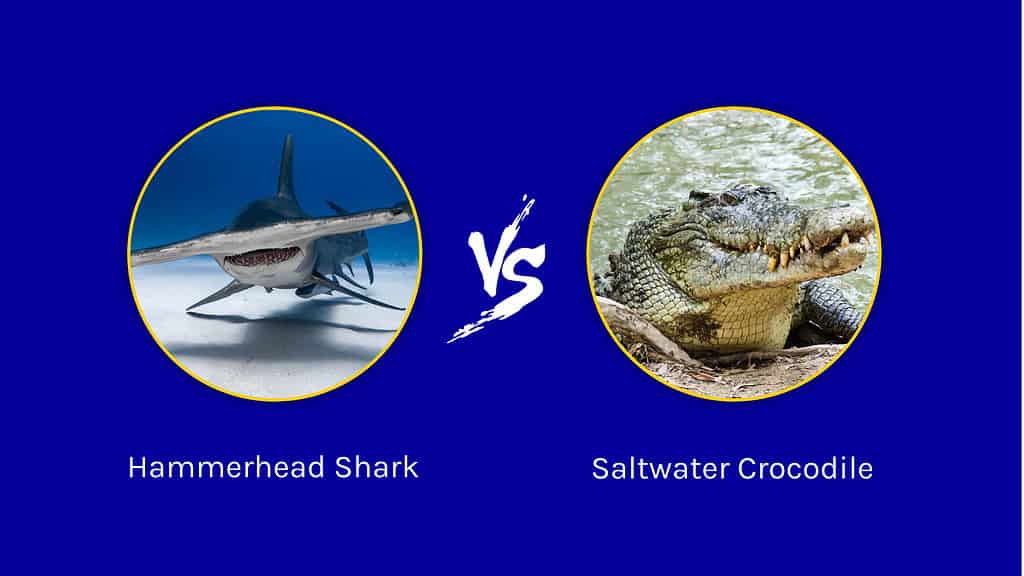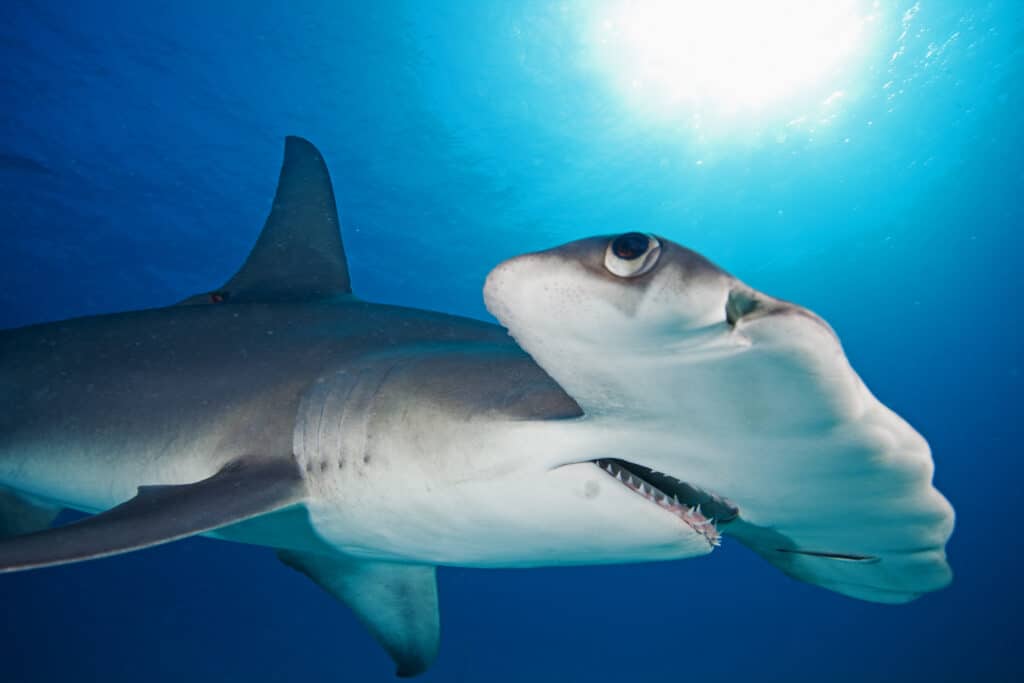Many fascinating battles go on in the animal world, with some being epic fights to the death. Some of the most unusual fights are those that occur in the water, and one such battle is that of a hammerhead shark vs. saltwater crocodile. Although not the most common occurrence, perhaps a hammerhead has strayed a bit too close to the shore and the croc decides to take a chance. Let’s explore what happens when it comes to this fascinating fight!
Comparing Hammerhead Shark vs. Saltwater Crocodile

| Hammerhead Shark | Saltwater Crocodile | |
|---|---|---|
| Size | Length: average overall 13 feet, largest species 12 to 18 feet Weight: largest species average 500 pounds | Length: average 11 to 20 feet Weight: typically up to 2,500 pounds |
| Physical Appearance | Distinctive T-shaped head. Tall dorsal fin, gray or brownish appearance. | Short legs, long body and tail, powerful jaws |
| Habitat | Temperate and tropical waters around the world, in both coastal and offshore locations | Coastal waters and rivers |
| Speed | Up to 25 mph | Up to 18 mph |
| Bite Force | 539 psi | 3,700 psi |
| Teeth | Approximately 300 teeth, typically small and triangular with slightly serrated edges | 66 teeth, up to five inches long, slightly curved and conical |
| Hunting Method | Opportunistic, solitary predators. May pin some prey to ocean floor | Opportunistic ambush predators. Typically drown prey but may roll and snap their neck. |
| Diet | Fish, crustaceans, rays, skates, squid, lobsters | Fish, birds, turtles, various mammals |
| Predators | Tiger sharks, great white sharks, orcas | Adults: no natural predators Juveniles: large lizards, birds, large fish |
The Key Differences Between Hammerhead Sharks and Saltwater Crocodiles

Hammerhead sharks can easily be distinguished by their T-shaped heads.
©Martin Prochazkacz/Shutterstock.com
There are many differences between hammerhead sharks and saltwater crocodiles, as well as the obvious differences in their appearance. These include their size, bite force, number of teeth, and kill method. These differences are also the key factors that will determine which animal would win in a fight. Let’s take a look at each one and decide which animal gets the edge in each category.
Hammerhead Shark vs. Saltwater Crocodile: Size
The first major difference between a hammerhead shark and a saltwater crocodile is the size difference. Saltwater crocodiles are the largest reptiles in the world. They exhibit sexual dimorphism, with the males being larger than the females. The females average 8 feet 10 inches to 10 feet 2 inches, while the male salties have an average length of 11 to 20 feet, although reports suggest that the largest may reach 23 feet. They are also extremely heavy, with weights typically ranging from 500 pounds for females to 2,500 pounds for males.
Although there are nine species of hammerhead sharks, even the largest species — the great hammerhead — can’t match the saltwater crocodile’s size. On average, great hammerheads range between 12 and 18 feet long. They also exhibit sexual dimorphism, although in this case the females are larger with an average of 15 to 18 feet, with a maximum of 20 feet. Despite getting close to saltwater crocodiles in length, great hammerheads just can’t match them for size. The heaviest great hammerheads are only around 1,000 pounds, which is not even close to the weight of the heaviest saltwater crocodiles. Therefore, in this case, saltwater crocodiles definitely have the size advantage.
Hammerhead Shark vs. Saltwater Crocodile: Physical Appearance
One of the biggest and undoubtedly the most obvious differences between hammerhead sharks and saltwater crocodiles is their physical appearance. Hammerhead sharks are known for their distinctive T-shaped snout. However, the size and shape can vary between species, with the great hammerhead having a straight front edge and others having a scalloped shape. In comparison, saltwater crocodiles have robust bodies with short legs and a long, powerful tail. They also have large powerful jaws which they can crash down on their prey with incredible force.
Hammerhead Shark vs. Saltwater Crocodile: Bite Force

Saltwater crocodiles have the largest bite force of any living animal today.
©Danny Ye/Shutterstock.com
As we’ve just mentioned, saltwater crocodiles have powerful jaws and this also means that they have an incredible bite force too. In fact, saltwater crocodiles have a bite force of a mighty 3,700 psi, which is the strongest bite force of any living animal today. In contrast, hammerhead sharks — specifically the larger great hammerheads — only have a bite force of 539 psi. This means that when it comes to bite force, saltwater crocodiles definitely come out on top.
Hammerhead Shark vs. Saltwater Crocodile: Teeth
Another important difference between these two mighty animals, and one that goes hand-in-hand with bite force, is the number of teeth that they have. Saltwater crocodiles have 66 conical-shaped teeth, whereas hammerhead sharks have up to 300 teeth which are arranged in several rows. Most hammerhead sharks have small, triangular-shaped teeth with small serrated edges which are perfect for cutting through flesh with. Therefore, in this category, the advantage goes to the hammerhead shark.
Hammerhead Shark vs. Saltwater Crocodile: Hunting Method
Finally, we have the difference between their hunting methods. Both animals are solitary apex predators, but how they catch their prey differs massively. Hammerhead sharks are opportunistic hunters and kill using devastatingly powerful bites. They attack and bite their prey until it is dead, often thrashing around in the water with it at the same time.
Saltwater crocodiles are also supremely capable and are ambush predators which use stealth to their advantage. They typically lie submerged in the water, waiting for the perfect moment to grab their prey, often as they are near the water’s edge. Once the crocodile has grabbed their prey they will usually drag it down into the water and drown it. They also often perform a “death roll” which serves two purposes. It can help the crocodile snap the neck of its prey, but also helps them tear off large chunks of flesh at the same time.
It’s difficult to say which is the more effective hunting method as each method is uniquely suited to the animal which uses it. Therefore, this category is a tie.
Who Would Win in a Fight Between a Hammerhead Shark and a Saltwater Crocodile?
Both hammerhead sharks and saltwater crocodiles are incredibly powerful predators and any fight between them would be a bloody battle right to the end. However, given that hammerhead sharks kill by biting their prey, we think that they would have a better chance of killing a saltwater crocodile outright, particularly if they can aim their bite at the saltie’s head or neck region. Despite this, saltwater crocodiles aren’t without a chance in a battle with a hammerhead, as they could possibly use their sheer size and bulk to overpower the smaller shark, especially if they can clamp their jaws down on it.
The photo featured at the top of this post is ©
Thank you for reading! Have some feedback for us? Contact the AZ Animals editorial team.







